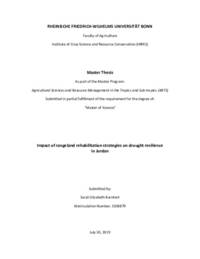Impact of rangeland rehabilitation strategies on drought resilience in Jordan

Authors:
Degradation of the Jordanian rangelands jeopardizes the food security and sustainable
development of the country. In response, organizations have implemented micro-water
harvesting, controlled grazing and protection rehabilitation techniques to improve vegetation
cover; however, there is a dearth of impact evaluations to identify which strategies are effective
and drought resilient. Using a remotely sensed vegetation index and two drought indices, I
evaluated twelve past interventions (i.e. four sites per strategy) from 2004 to 2018. Five focus
group discussions validated the causal framework and provided insight into the quantitative
data. Over fifteen years, only seven sites had a positive vegetation cover trend, three of which
were controlled grazing sites. A double difference impact evaluation for controlled grazing and
micro-water harvesting interventions indicated that vegetation changes were minimal, but a
pooled, ordinary least squares regression revealed that controlled grazing had a significant a
positive impact and micro-water harvesting a negative effect, driven by late rainy season values.
A fixed effects model similarly revealed that controlled grazing had a significant impact in the
late rainy season, but this finding was not robust. The results suggest that rehabilitation did not
transform the degraded system; however, this could be due to counterfactual site identification
process, which may have captured barely cultivation or irrigated agriculture. Regardless,
interventions appeared drought resilient based on the ANOVA, Spearman’s correlation and
regression results, but this is likely due to an overall lack of vegetation. Based on these results,
decision makers may conclude that rehabilitation is not a worthwhile investment; however,
rangelands provide essential ecosystem services. Inaction is not a viable option. Instead,
organizations should promote controlled grazing, actively monitor ongoing interventions and
conduct more robust evaluations to identify strategies that improve the long-term natural
capital of the rangeland.
